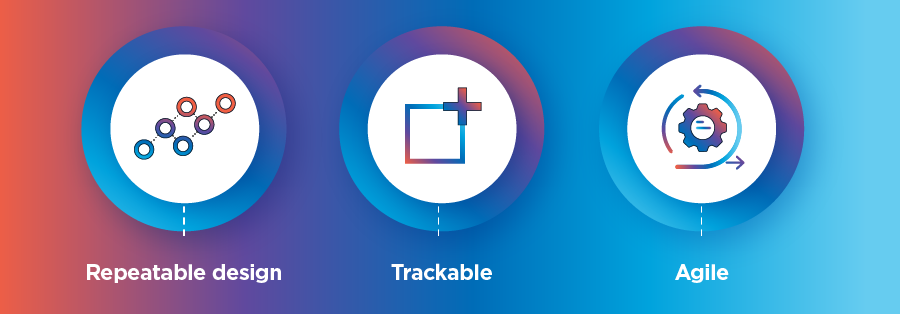What Is a Business Process?

Reliable (and repeatable) business tasks equal a reliable business. So, how do you take your repeatable business activities and make them better, helping you grow and increase profitability? That’s what we’re here to discuss.
What is a business process?
A business process is the bread and butter of any organization. Simply put, it’s every task, activity and workflow happening inside your business that makes it run and achieves your business goals. It’s how your people get things done, usually in a collection of repeatable steps. So, if your business processes aren’t running efficiently, neither is your business.
What Are the Attributes of a Business Process?
A business process is how your organization gets from point A to Z successfully. Most processes tend to have a defined target of what you’re trying to accomplish. To reach consistency, a business process ought to contain repeatable, standardized steps.
A good business process will contain the following:
- Repeatable design: In its nature, a business process is routine, meaning it happens more than once in the business. An example is the process of paying invoices versus making a one-off purchase of a new property.
- Trackable: A good process is one you can monitor. You should be able to make sense of the steps within the process. This allows you to compare its performance over time and eliminate any inefficiencies or bottlenecks.
- Agile: An inflexible process won’t hold up to a dynamic, ever-changing market. A good business process can adapt to multiple situations and environmental changes, helping you avoid delays. In the case of permanent changes, such as updated regulations, you should be able to implement these adjustments rather seamlessly.

Why are business processes important?
So, why does it matter if you have a good process? Besides wanting consistent and reliable outputs for your business, a good process is also suited for automation. By introducing intelligent automation (IA) into the mix, you can create even better efficiencies and reduce the number of time-consuming, repetitive tasks for your human workforce.
IA, also called digital process automation, combines robotic process automation (RPA), business process management (BPM) and artificial intelligence (AI) to automate manual tasks, improve business processes and increase efficiency across the overall business. IA software like SS&C | Blue Prism® Enterprise allows you to deploy a robust digital workforce into your business processes without requiring an infrastructure overhaul.
To ensure your automation efforts are effective, you’ll want to establish a business strategy. That includes identifying and optimizing selected existing processes so they’re easier to automate. SS&C | Blue Prism® Capture enables you to accurately capture your as-is processes and create a process definition document (PDD), which equips your developer with everything they need to build an automation. Meanwhile, process intelligence software like SS&C | Blue Prism® Process Intelligence uses process and task mining with analytics to allow organizations to capture a highly accurate, data-driven view of their current processes and tasks.
A business process example
Say you have a new hire joining the organization. Your human resources (HR) department likely follows the same steps for every joining employee to ensure they get what they need to start. The steps within the onboarding business process might include:
- HR recruiter posts an availability on a job board.
- Multiple candidates apply for the job.
- HR person screens the candidates, filtering out those who don’t fit the bill.
- Contact candidates for the first round of interviews.
- Schedule and conduct interviews, possibly followed by further rounds of meetings and interviews.
- Select a favored candidate.
- Negotiate salary and policy.
- Send the offer letter.
- The candidate accepts the offer.
- Issue the new hire all their starting software, hardware and training materials.
In general, these are the steps you’d take to onboard a new employee. With business process automation, you have digital workers ensuring each step is completed before moving on to the next one. That means your new hire doesn’t spend their first few weeks in the business without a laptop or without critical software they need to do their job. It’s efficiency and professionalism wrapped up in one neat bow, and it also takes the burden off your busy HR department.
What Are the Types of Business Processes?

There are broadly three types of business processes that sit on different levels of the organization. Each type is critical to the functional success of the business.
Operational processes
As the name suggests, these are how businesses operate at the ground level. They’re also called core business processes because they provide direct value to the customer and the organization itself. They’re the primary providers of revenue for the business. Examples of these processes include product manufacturing, order-to-cash processes and delivery of products and services to customers.
Support processes
This is how you support your core operational processes so they perform seamlessly. Though support processes don’t directly contribute to generating revenue, they help your internal departments establish a collaborative and aligned environment. Supporting processes help expand a business. Examples of these areas live in HR, finance management administration, operations, etc.
Management processes
As you might expect from the name, management processes cover the planning, monitoring, managing and controlling of the operational and supporting end-to-end processes. Management processes focus on the business goals and ensure everything runs efficiently and is aligned with what the business wants to achieve. The focus is on monitoring internal and external business functionalities, identifying challenges and opportunities and nurturing a movement of continuous growth and improvement in all processes.
Other processes
Beyond these three, there are also sales processes, supply chain, marketing and customer service.
What Is Business Process Technology?
This covers any software or tool used for optimizing business processes. The goal of technologies like IA are to reduce human errors, save time and resources, and free people from manual tasks so they can focus on higher-value initiatives. Business process technology can also extend to customer relationship management (CRM) systems, enterprise resource planning (ERP), workflow or project management software and so on.

Benefits of a business process software
BPM platforms such as SS&C | Blue Prism® Chorus can help orchestrate workflows, people and systems, making it easier to deploy effective automated processes across your organization and manage your time and resources better. Let’s look at some benefits of using BPM to boost your processes:
Allocate resources better
By monitoring your processes, you can identify and eliminate duplicated efforts. That means your people can work on higher-value tasks, and you're not spending money on low-value or unnecessary work.
Cost savings
Get rid of the waste. With BPM and IA, you can keep your costs low by making work more efficient and getting rid of the things your organization doesn’t need.
Fewer risks
BPM gives you better visibility and management over your workflows. This allows a more proactive approach to your processes by enabling you to fix errors and minimize bottlenecks, which can put your business at risk.
Improved collaboration
With better transparency comes better collaboration between your people, vendors and customers. Streamlined communication and automated notifications mean no one gets left behind or forgotten.
Increased productivity
Once you’ve optimized your business processes, everything runs faster and better – faster approvals, better access to information and routine tasks routed to digital workers without requiring human intervention. That means your teams are producing results for the business.
Maintained compliance
BPM software creates fully transparent audit trails showing how your processes perform and keeps you up to date with changes in industry regulations. This helps you stay compliant.
Happier people
Improve employee and customer satisfaction by providing more streamlined services. BPM with IA makes work more interesting for your people and delivers better, faster results to your customers.
What Business Process Categories Are There?
Below, we’ve outlined the steps of a business process lifecycle, which should help you model and identify the steps in your own business processes, and how you can go through the process of implementing automation.
- Define your final goal for the process.
- Map your as-is process with a broad table of contents.
- Dig deeper to identify each action and any people involved.
- Evaluate how the process performs, looking for gaps and room for improvement.
- Implement your new and improved process.
- Monitor how it performs with your changes.
- If the results are good, repeat these steps for the next process.
A Few More Helpful Terms
Now, let’s dig into a few big terms you’ll hear when talking about business processes.
Business process analysis
The process of identifying business requirements and deciding on solutions (e.g., process improvement, developing policies, strategic planning, etc.).
Business process compliance
This is the process of following the rules, policies, regulations and standards laid out for an organization’s day-to-day operations.
Business process development
Business process development and management is the process of designing, creating and implementing new business processes or changing existing ones.
Business process diagram
The diagram or model is a structural representation of your business activities within every step.
Business process flow
This is also a representation of your processes shown as a form or flow chart. The business process flow shows each stage and step completed in the process.
Business process improvement
This is a strategic initiative for improving business processes by finding inefficiencies and weeding them out. It can include process mapping and aligning with organizational goals.
Business process innovation
The idea of business process innovation is taking your processes to the next level beyond improvement to looking for opportunities for digital transformation. You can do this by introducing new technologies, methodologies or strategies.
Business process integration
Here’s where you define a process model showing the sequence, hierarchy, events, logic and data movement between systems.
Business process mapping
Process mapping is where you document, clarify and show your process sequences in logical steps. It is often shown as a flow chart. Process mapping software allows business users to map all processes with an intuitive visual interface.
Business process modeling
Business process modeling is a way for businesses to show the flow of their business activities as a diagram. It’s primarily used to document the current flow of activities and help locate areas for improvement. Tools like the SS&C | Blue Prism® Process Assessment Tool (PAT) will help you build a consistent pipeline of automation opportunities by helping you evaluate, validate, scale, monitor and export your processes.
Business process monitoring
This is the act of monitoring processes and activities so you can gain insights into important transactions within your organization.
Business process notation
The business process modeling notation is a globally accepted standard used by most professionals modeling out their as-is processes, and it’s a great first step toward adopting automated processes.
Business process orchestration
This is another term for business process management (BPM). It helps organizations bring together disparate systems, people, digital workers and workflows.
Business process redesign
Also called business process reengineering, this is where you completely redesign a business process after analyzing it and deciding it needs a total restructuring. This involves identifying inefficiencies, removing unnecessary tasks and even implementing top-to-bottom change.
Business process simulation
This is a tool for measuring process performance, testing process design and identifying any bottlenecks or necessary changes. It’s also a way to test how your process operates in different environments or with different data or instructions.
Business process standardization
This involves establishing and implementing consistent procedures across your organization to achieve a standard set of how things are done. Following an operating model such as the SS&C | Blue Prism® Robotic Operating Model™ (ROM2) can help organizations achieve this.
Business process transformation
This is the idea that an organization will completely change how their operations run, often done by introducing totally new systems, technology or ways of working. The aim is to meet business goals and align people, processes and technology.
Continuous process improvement
This goes beyond process improvement to fostering a culture of constant evolution and improvement. It involves people across the business in finding new ways to adapt and improve.
Process efficiency
Achieving process efficiency is a journey of identifying slowdowns or bottlenecks and removing them to streamline an entire process.
Process vs procedure
A process is a high-level view of the series of actions or activities taken in your business to achieve an outcome. A procedure is a detailed look at each step taken to complete the process, with specific instructions on how to perform a task.
What’s Next?
The better the business processes, the better for the business. Efficient processes mean you’re not wasting time, money or valuable resources, and it helps you focus your efforts on the things that matter.
Technologies like intelligent automation and business process management can help you improve work across your business. Well-defined and optimized business processes will help you drive organizational success and outline new strategies and technologies to continuously improve.